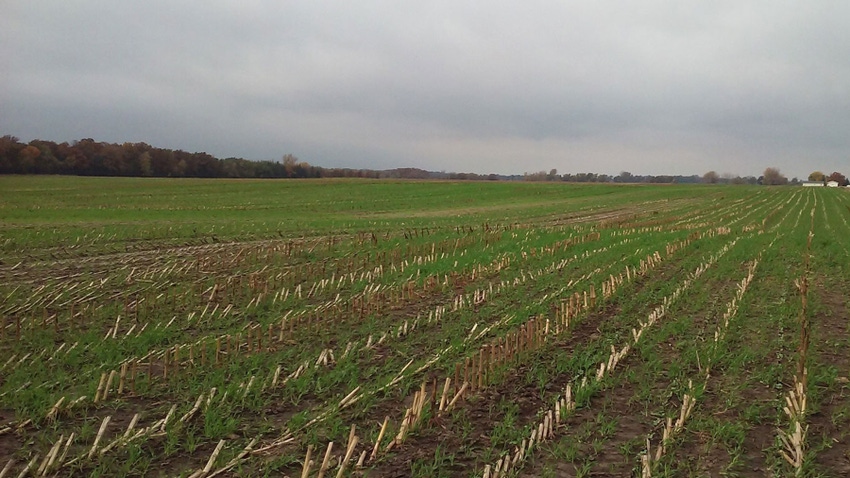
Dairy and beef producers continue to be hit with the high cost of forages. Finding ways to grow forages economically is a great strategy for boosting feed inventories and lowering overall feed costs, says Jerry Clark, University of Wisconsin-Extension crops and soils agent in Chippewa County.
“The whole cover crop push is to keep something living on the land,” Clark says. “Rye and triticale are great to plant in the fall and then harvest for feed in May.”
Clark says in August, farmers can plant oats and radishes for feed in the fall. “You can chop it or make baleage,” he explains. “It’s a great early-season forage that can be chopped. It’s OK to plant oats late summer following wheat because you are not harvesting the oats as a grain.”
Clark says this helps dairy and beef producers get extra forage off before they plant corn silage the end of May. Annual ryegrass and meadow fescue are other options for summer and fall forage.
Josh Hiemstra farms 790 owned and rented acres with his dad, Bob, near Brandon in western Fond du Lac County, Wis. The Hiemstras milk 150 Holstein cows, and raise 100 dairy heifers and calves, and 175 head of dairy-beef.
Extra forages
The Hiemstras began growing cover crops 16 years ago to help boost soil health and to provide additional feed for their dairy cattle. After harvesting corn silage last fall, they seeded 75 acres of ryelage and triticale mixed.
“The triticale matures a little later than the ryelage,” Josh Hiemstra says. “I planted 60 pounds of each to the acre. If you are going to seed rye and triticale for feed, you need to seed them heavier than you would for just a cover crop.”
While some farmers like to apply urea on their rye or triticale to boost tonnage, Hiemstra applied 7,000 gallons of liquid manure per acre last fall after seeding the crop.
“Rye is very tolerant of manure applications,” he says. “I planted the rye and then spread manure. Silage came off, we no-tilled the rye, and then it came up.”
He plans to chop the rye and triticale mix for feed for the heifers when it is ready in mid- to late May.
“Then I’m going to double-crop those 75 acres,” Hiemstra says. “I will plant canning peas on some of it; I will plant soybeans on some of it, and the rest I will plant corn for silage.”
On the ground that he plans to double-crop with canning peas, Hiemstra figures he will get four crops off that land in two years.
“I had corn silage on it last year and seeded the rye and triticale in early October. Then after I chop the ryelage and triticale in May, we’re going to put canning peas in,” he explains. “It will be harvested in July, and then we’ll fall-seed alfalfa in August. So, I’m going to get four crops off those acres in two years. I won’t harvest the alfalfa this fall, but it will be ready to go next spring.”
Hiemstra says they plan to feed the ryelage and triticale to their heifers.
“We avoid feeding our heifers our good haylage. We need that for the cows,” he says. “But we have fed triticale and ryelage to the cows in the past. It makes great feed. You just have to harvest it early. If you are feeding it to heifers, it can be harvested after the rye heads out.”
The Hiemstras’ herd averages 85 pounds of milk per cow per day.
“We milk twice a day. Our cows have a 4.2% fat and a 3.2% protein,” he says. “We’re shooting for 6.3 pounds of total solids or 100 pounds of energy-corrected milk per cow per day.”
Inexpensive feed
Hiemstra figures it costs him about $65 an acre to seed 60 pounds of triticale and 60 pounds of rye, plus harvesting costs.
“It’s a very economical feed. At 3 tons to the acre, that works out to about $22 per ton plus harvest costs,” Hiemstra says. “That’s pretty cheap. You are getting feed worth $100 a ton or $300 an acre. Figure you are spending $100 an acre for that crop, and you are getting $300 worth of feed per acre.”
In addition to growing cover crops for feed, Hiemstra says he seeded rye on all their soybean and corn ground last fall.
“I seeded it at 60 pounds per acre. Rye is the hardiest cover crop to seed in the fall in early October,” he says. “I’ve put it in as late as Nov. 1. It just depends on how desperate you are — it will grow. It makes great feed. It’s a little more economical to plant than triticale, but the feed value isn’t as high.”
Read more about:
BeefAbout the Author(s)
You May Also Like






